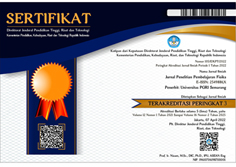Keefektifan Pembelajaran Fisika dengan Pendekatan STEM untuk Meningkatkan Kreativitas Mahasiswa
Abstract
Full Text:
PDFReferences
Riddle M 2009 ICTs in the daily lives of Australian students: A pilot study (http://www.matthewriddle.com/ict-study)
Fisher D and Frey N 2008 Better learning for structured teachers: A framework for the gradual release of responsibility (Alexandria VA: ASCD)
The Partnership for 21st Century Skills 2011 Framework for 21st century Learning (http://www.p21.org/storage/documents/1.p21)
Greenstein L 2012 Assessing 21st Century Skills: A Guide to Evaluating Mastery and Authentic Learning (Corwin: Sage)
Cohen L N M and Ambrose D 1999 Adaptation and creativity: Runco MA and Pritzker, S R (Ed) Encyclopedia of creativity (Sandiego: Academic Press)
Munandar U 2006 Mengembangakan bakat dan kreatifitas anak sekolah (Jakarta: PT. Gramedia Widiasarana)
OECD 2014 PISA 2012 results: creative problem solving student’s skills in tackling real-life problems (Cyprus: OECD Publishing
Greiff S, Wustenberg S, Csapo B, Demetriou A, Hautamaki A, Graesser A C and Martin R 2014 Domain-general problem solving skills and education in the 21st century Educational Research Review 13
Maulana Y 2014 Pendidikan berbasis STEM membentuk siswa lebih kritis (https://news.okezone.com/read/2014/12/04/65/1074832/)
Bybee R W 2013 The case for STEM education: challenges and opportunities (Arlington- Virginia: National Science Teachers Association Press)
Hannover R 2011 Successful K-12 STEM education: Identifying effective approaches in science, technology, engineering, and mathematics (Washington DC: National Academies Press)
Bligh A 2015 Towards a 10-year plan for science, technology, engineering and mathematics (STEM) education and skills in Queensland (Queensland: Department of Education, Training and the Arts)
Fraenkel J R and Wallen N E 2009 How to design and evaluate research in education (7th ed) (New York: McGraw-hill)
Hake R 1998) Interactive-engagement versus traditional methods: A six-thousand-student survey of mechanics test data for introductory physics courses American Journal of Physics 66(1)
Suharsimi A 2010) Manajemen penelitian (Jakarta: Rineka Cipta)
Dunkin M and Biddle B 1974. The study of teaching (New York: Holt, Rhinehart & Winston)
Zimmerman B J and Schunk D H 2012 Self-regulated learning and academic achievement: Theory, research, and practice (New York: Springer Science & Business Media)
Siswanto J, Susantini E and Jatmiko B 2018 Practicality and effectiveness of the IBMR teaching model to improve physics problem solving skills Journal of Baltic Science Education (JBSE) 17(3)
Furi L M I, Handayani S and Maharani S 2018 Eksperimen model pembelajaran project based learning dan project based learning terintegrasi STEM untuk meningkatkan hasil belajar dan kreativitas siswa pada kompetensi dasar teknologi pengolahan susu Jurnal Penelitian Pendidikan 35(1)
Sari R H 2017 Pengaruh implementasi pembelajaran STEM terhadap persepsi, sikap, dan kreativitas siswa Prosiding seminar nasional MIPA III (Langsa-Aceh: Unsyiah) p 416
Kristiani K D, Mayasari T and Kurniadi E 2017 Pengaruh pembelajaran STEM-PjBL terhadap keterampilan berpikir kreatif Prosiding seminar nasional pendidikan fisika III (Madiun: Universitas PGRI Madiun) p 266
Harris A and de Bruin L 2017 STEAM education: fostering creativity in and beyond secondary schools Australian Art Education 38(1)
Mayasari T, Kadarohman A, Rusdiana D and Kaniawati I 2016 Exploration of student’s creativity by integrating STEM knowledge into creative product AIP conference proceedings 1708, 080005
Henriksen D 2014 Full STEAM ahead: creativity in excellent STEM teaching practices The STEAM Journal 1(2)
DOI: https://doi.org/10.26877/jp2f.v9i2.3183
Refbacks
- There are currently no refbacks.
Copyright (c) 2018 Jurnal Penelitian Pembelajaran Fisika

This work is licensed under a Creative Commons Attribution-ShareAlike 4.0 International License.
Attention:
Starting vol. 15 issue 4 October 2024 JP2F has moved to a new website address
https://journal2.upgris.ac.id/index.php/jp2f/index
The submission process will only be served on the web above.
Copyright of Jurnal Penelitian Pembelajaran Fisika ISSN 2086-2407 (print), ISSN 2549-886X (online)
Gedung Utama GU.2.01 FPMIPATI, Universitas PGRI Semarang
Jl. Lontar No. 1-Dr. Cipto, Kampus 1 UPGRIS, Semarang
Email: jp2f@upgris.ac.id








